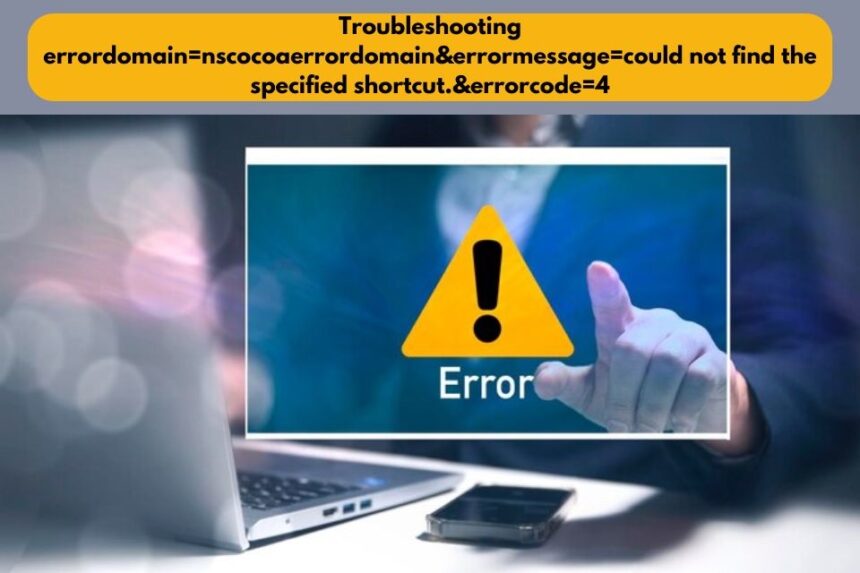Errors are an inevitable part of technology. One perplexing error encountered by users of macOS and iOS is errordomain=nscocoaerrordomain&errormessage=could not find the specified shortcut.&errorcode=4. This error, though technical in nature, stems from straightforward causes such as missing resources or misconfigured shortcuts. Understanding the nature of the problem is the first step toward resolving it.
In this article, we will explore why this error occurs, the role of NSCocoaErrorDomain in Apple’s framework, and step-by-step methods to troubleshoot it efficiently.
Understanding NSCocoaErrorDomain: A Core Component
The term NSCocoaErrorDomain is specific to Apple’s Cocoa framework, which forms the foundation for macOS and iOS applications. Errors within this domain usually indicate issues related to file handling, user preferences, or resource management.
In this case, the error points to the system’s inability to locate a specific shortcut or resource needed to perform an action. The associated error code (4) further narrows it down to a missing file or invalid shortcut configuration.
Key Causes Of errordomain=nscocoaerrordomain&errormessage=could not find the specified shortcut.&errorcode=4
- This error commonly occurs when a shortcut references a file or resource that no longer exists on the system.
- New updates to macOS or applications may introduce changes that disrupt existing shortcuts, leading to this error.
- Accidental deletion, modification of shortcuts, or incorrect system preferences can also trigger the error.
- Two or more applications attempting to access the same shortcut may cause a resource conflict.
- Corrupted or outdated registry keys can create inconsistencies in shortcut management.
- Malicious software can interfere with file integrity, resulting in missing resources or corrupted shortcuts.
Step-by-Step Troubleshooting Guide
Step 1: Verify the Resource or Shortcut
Start by checking if the resource or file linked to the shortcut exists. If it has been moved, restore it to its original location or update the shortcut path.
Step 2: Update macOS and Applications
Ensure that your operating system and all installed applications are updated to their latest versions. Updates often resolve bugs and compatibility issues.
Navigate to System Preferences > Software Update to check for macOS updates.
Update applications via the App Store or their respective update mechanisms.
Step 3: Reboot Your System
Rebooting your Mac is a simple yet effective way to resolve temporary system glitches and refresh configurations.
Step 4: Review Shortcut Settings
Go to System Preferences > Keyboard > Shortcuts and review all shortcut configurations.
Ensure the problematic shortcut is correctly set up and does not conflict with others.
Step 5: Use a Registry Cleaner
Run a trusted registry cleaner to scan for and fix corrupted or erroneous keys that might be causing the error.
Step 6: Run a Malware Scan
If malware is suspected, install a reputable antivirus program and perform a full system scan. Remove any threats detected during the process
Step 7: Reinstall Problematic Applications
If the error is linked to a specific app, uninstall and reinstall the application. This replaces any missing or corrupted files.
Step 8: Restore System Files
Use Time Machine or another backup utility to restore your system to a previous state when the error was not present.
Step 9: Contact Apple Support
If all else fails, contact Apple Support for professional assistance. Provide them with the exact error message and details of the steps you’ve already taken.
Preventing The Error In The Future
- Keeping your macOS and applications updated ensures compatibility and prevents errors arising from outdated software.
- Regularly back up your files and resources using tools like Time Machine. This protects against accidental deletion and resource loss.
- Periodically review and organize your shortcuts to avoid misconfigurations or conflicts.
- Install reliable antivirus software and conduct regular system scans to prevent malware-related issues.
Wrap Up
The error errordomain=nscocoaerrordomain&errormessage=could not find the specified shortcut.&errorcode=4 might initially appear daunting, but understanding its origins simplifies the troubleshooting process. By verifying resources, updating software, and addressing system conflicts, users can resolve the issue effectively. Preventative measures, such as regular updates and backups, can further minimize the chances of encountering such errors in the future.
Ultimately, this error serves as a reminder to maintain organized systems and to stay proactive about device maintenance. With the solutions outlined here, you can regain smooth functionality on your Mac or iOS device.
FAQs
What does error code 4 mean in NSCocoaErrorDomain?
Error code 4 indicates a missing file or resource that the system cannot locate, often due to deletion or relocation.
Can malware cause this error?
Yes, malware can corrupt essential files or shortcuts, leading to this error. Performing a malware scan can help resolve the issue.
How do I prevent this error in the future?
Regular updates, backups, and periodic shortcut reviews can help prevent this error from occurring.
What should I do if none of the troubleshooting steps work?
If the error persists, contact Apple Support for professional assistance. They can provide further guidance specific to your issue.










